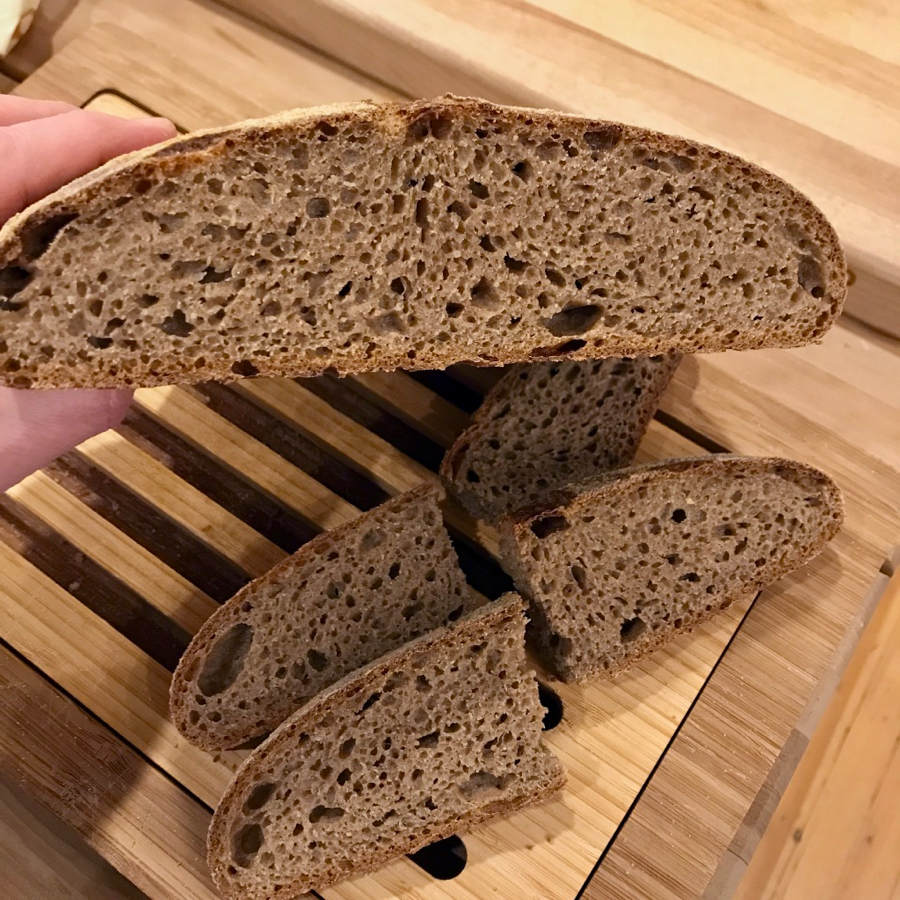
Why did my dough spread out so much? (photo & details provided)

I make a lot of 100% sourdough whole grain batards from home-milled wheat, but this one came out more like a ciabatta height, and I'm not sure why.
Flavor is great and crumb structure is to my liking, but from the moment I tipped the proofed dough out of the banneton, it wanted to spread sideways and it only got worse in the covered cast iron cooker.
Suspects: (1) I increased hydration from 78% to 80% to see if I could get a bit more open structure. (2) It's possible the loaf was somewhat underproofed before shaping as I didn't bulk for as long as normal, or (3) Or was it overproofed after shaping? I also let it rise an hour longer than usual before and after the fridge. Otherwise, formula and process was the same as other bakes that didn't flatten out like this.
- Flour blend of heritage hard red winter wheat: 2/3 Red Fife (14% protein), and 1/3 Redeemer (12% protein). Milled at home right before mixing, 100% extraction.
- Levain was 16% of flour weight (8% prefermented flour). Added quite young 3 hours after a 1:1 final refresh , but it passed the float test.
- Mixed by hand; Autolyse with levain, most of the water and flour for 40 minutes, then added salt and reserved water. 80% hydration (usually I do 78%)
- Bulk ferment about 3 hours at 74F with 4 stretch and folds at 30 minute intervals at the outset. Bench rest 15 minutes, shaped the same way I always do with plenty of tension.
- Another hour of proofing in the banneton, then fridged overnight.
- Baked next morning the usual way, 2 hours out of the fridge, in a cast iron covered cooker preheated for an hour at 450F
Usually I fridge it sooner after shaping, and bake it sooner out of the fridge, but the shorter bulk fermentation seemed to want more proofing time. Normally this wheat blend is pretty strong and I was surprised to see it almost collapse on me.
So what do you think? Underproofed? Overproofed? Just too wet despite only a 2% increase in hydration? Levain not really ready even though it floated? Something else?


How long did you mix the dough? I guess it's this flat because the gluten network wasn't developed really far, so it didn't have enough strength to support all the gases and growth. Plus you had quite high hydration.
There is nothing wrong with the bread, it looks properly proofed with a great crumb and crust. But little mixing in combination with high hydration results in flatter breads.
Thanks! I hand mixed the same way I always do, which is just 2 or 3 minutes until the flour is incorporated, and then another 2-3 minutes working in the salt and reserved water after autolyse. Normally I get good gluten development with the higher hydration combined with the folds and the loaves don't spread that much, but it's good to know that mix time can be a factor. I've never really explored extended mix times but perhaps I should try it.
Glad you don't see any flaws in the crumb/crust.
Does 80% seem high for 100% whole grain, fresh milled flour? It certainly would if I had any white flour in there but this dough wasn't especially ornery to work with, sticky-wise.
I read somewhere that it's basically impossible to overknead a dough by hand, but usually about 10 min. is recommended.
80% is a good hydration, whole wheat absorbs more water than normal wheat flour. I have seen whole wheat recipes with 90% hydration and they turned out fine.
Also, whole wheat flour usually yields a weaker gluten network (not significantly, but noticeable), due to all the bran interfering with it and cutting through the gluten strands. So when working with whole wheat (or other flours with weaker gluten such as rye and spelt), treat the dough more gentle when stretching & folding and shaping to not damage the strands further.
It looks about right for the high hydration/weak gluten dough. It probably would have worked better had you baked straight from the fridge. Also, there's no need to preheat cast iron for an hour - if you put it in the cold oven it will be ready pretty much when the oven is hot.
I've always wondered if baking straight from the fridge would be OK. The cold dough would certainly spread less. My bread books offer different opinions on the subject. I assume that if I'm doing that, I need to make sure I let the dough proof long enough at room temperature before the fridge, as I usually don't see much rise overnight in the fridge.
Thanks for the tip about cast iron - will give that a try. I do have an infrared thermometer so I can easily check the surface temp of the pot.
@Top, I learned that you don't have to visually see a rise when proofing in the fridge. The CO2 gas just doesn't expand as much in a cold heavy dough. And perhaps the gas disolves more in the water and grain. It takes a couple hours for the dough to cool down once it goes in the fridge, especially if you bag it.
I bake loaves of nearly 100% whole grain too. My best oven spring is after a short proof (1 to 1.5 hrs) at room temp, or when going straight from fridge to the oven after an overnight.
A thing with whole grain baking, the bread still ferments/proves (proofs?) even when you don't see it rising. I was over-proofing, but the dough wasn't holding all the gas, so it tricked me into thinking it was under-proofed.
DanAyo told me to bake it _before_ I thought it was ready, so I tried it, and that taught me that I was mis-judging it, and actually over-proofing. Now I get better oven rise and crumb.
Also, I match my round banneton to the inside bottom diameter of my Lodge 3.2 qt combo cooker. That way I don't get sideways spread, it just expands up. 8" I.D. when baking in the deep part, 9" I.D. when baking on the lid/skillet part. With the long handle on the Lodge, I invert it over the banneton, and flip them both over together.
If you're willing to "cheat" a little, 1/8 to 1/4 tablet of a 500 mg vitamin C tablet, and 2 tsp of vital wheat gluten per 625 g of flour has helped me get better rise and crumb with 100% home-milled whole grain.
Bon appétit, amigo.
Yesterday I baked earlier in the proof than I usually do, and even at the same flour blend and hydration, the dough was stronger with better oven spring than usual. Caveat: this was 2/3 high extraction flour (~85%) and 1/3 whole grain so the gluten network was stronger, but I'll try this on the next 100% whole grain loaf I bake.
I'd completely forgotten about ascorbic acid as a dough strengthener - I used to use it for my home-milled flours and then fell out of the habit. I actually have a little bottle of it that I no doubt overpaid for over mail order, given that Vitamin C tablets are the same thing!
Hi TopBun,
I am new to this bread world and have had a flop rise like you show, with white flour, on a Bloomer. My research told me to add 1/2 tsp of baking powder, NOT soda, and it improved the rise. If this works it will be cheaper and purer than tablets.
Love this site, can't stop learning.
You guys in the states are so lucky with the ingredients you have available, especially the flours. Here in South Africa, we have only four types of bread flours. If we want Spelt or similar flour it cost 8 time the price of whole wheat stone ground to import I really envy your choices.
Enjoy.